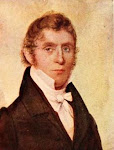 In the second half of the 19th Century the ships of the British Royal Navy patrolled the world's seas in an ernest attempt to stop the trans-Atlantic slave trade. Much of their valiant labor seems lost to history, good deeds being more easily forgotten than wicked ones, it seems.
In the second half of the 19th Century the ships of the British Royal Navy patrolled the world's seas in an ernest attempt to stop the trans-Atlantic slave trade. Much of their valiant labor seems lost to history, good deeds being more easily forgotten than wicked ones, it seems.Today we tend to only remember that the trade existed, forgetting that people were also trying to stop it.
Our historical amnesia may get a needed jolt by the recent discovery of a 400-page diary. The journal belonged to doctor Richard Carr McClement, an Irish assistant surgeon who served aboard six Royal Navy ships patroling West Africa between 1857 and 1869.
In that capacity he became an eye-witness to the vicious cruelty that seems to always follow in the wake of the evil that is slavery. Researcher Dr Karly Kehoe describes what she's found in her preliminary readings of McClement's journal:
“As a surgeon working on the west African patrol, Mr McClement was called upon to assess the health of slaves whenever a slaver captured a slave. You get a sense by the way he writes that he was touched by the sheer human misery. He couldn’t really believe what he was seeing. He would have seen extreme poverty in Ireland having lived there during the famine, and would have known about discrimination, but this was all of a different order.”The report from Scotland's Sunday Herald contains an except from McClement's journal entry for January 7, 1861, revealing the horrible scene waiting for him when he boarded the intercepted slave ship the Clara Windsor:
9am went on board the Clara Windsor. It would be utterly impossible to describe the sight which presented itself to us when we first went on board, and it would be equally difficult for any one who had not seen it, to comprehend the amount of misery, the suffering and the horrors, that were contained within the wooden walls of that little craft.
The ship is about 250-tons burden, and has her slave deck running right fore and aft, which is about three feet in height. The stench from the vessel is so great, that even at the distance of 200 yards to leeward it is almost insufferable.
When I went on board, the majority of the slaves were on the upper deck, mostly squatting in rows, each row sitting between the legs of the one behind it.
On the foetid, sloppy and sickening slave deck were to be seen the remainder, consisting of men, women, and, children, huddled together; some emaciated to skeletons; some lying sick and heedless of all around; and, some on the point of passing into another world, where it would be hard to imagine they could suffer more than they had done in this; men and women lay promiscuously, some lying on their faces, some on their backs; and, the more enfeebled sat with their heads resting on the knees.
All were naked and had their skins besmeared with the filth in which they lay. On the upper deck were to be seen slaves of all ages from 30 years downwards; here also men, women and children lay or sat promiscuously and presented the same appearances as those on the slave deck. A skeleton woman – quite naked – might be seen in a dying state, with an infant sucking the already half dead breast, while adjoining might be seen another apparently dead; her shrivelled breasts showed that her milk had long since gone, yet a starving baby held the nipple in its mouth and struggled hard to obtain what man’s cruelty had robbed it of.
Here, indeed might be seen a specimen of that affection which nature implants in the bosom of woman, for her children, and, which, would show that the civilised and uncivilised possess it alike. In every case of misery, and where the woman was even senseless, or, apparently dead, or dying, her little baby was firmly clutched to her bosom as if it were the only tie that held her to life.

No comments:
Post a Comment